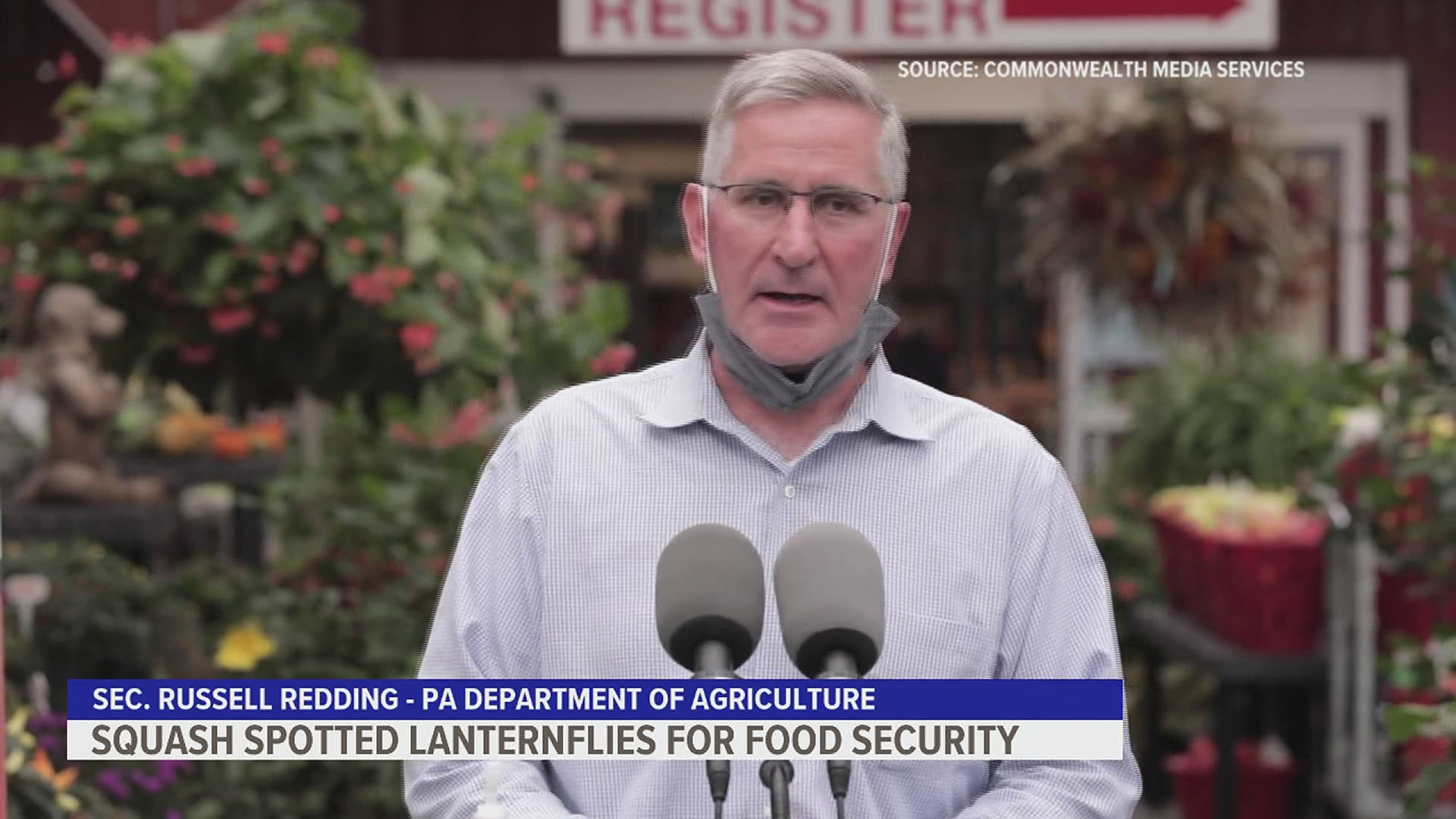LANCASTER, Pa. — At an appearance at Lancaster's Cherry Hill Orchards Thursday, Pennsylvania Department of Agriculture Secretary Russell Redding and other officials urged residents to keep squashing any Spotted Lanternflies they encounter to help protect the commonwealth's food supply.
“I’ve said time and time again throughout the COVID-19 crisis that we will not accept hunger as our next pandemic,” Redding said. “But we all need to act now to fight a small, but mighty threat to Pennsylvania’s leading agriculture industry and ensure a diverse variety of food is available tomorrow.
“If you see a Spotted Lanternfly, squash it. Report it. Check your car before traveling. These small acts make all the difference for our farmers working hard to feed Pennsylvania and the nation.”
Native to Asia and first found in Pennsylvania in 2014, the Spotted Lanternfly is capable of decimating entire grape vineyards and damaging fruit orchards, hops, walnuts, hardwoods and decorative trees, Redding said. These industries contribute billions annually to Pennsylvania’s economy.
According to an economic impact study completed earlier this year by Penn State’s College of Agricultural Sciences, the Spotted Lanternfly could cost Pennsylvania up to $324 million annually in economic impact with a loss of more than 2,800 jobs if not contained.
In addition to endangering agriculture, the Spotted Lanternfly threatens our ability to enjoy the outdoors during spring and summer months, according to Redding. They’re known to swarm in the air, cover trees, and coat decks and play equipment with their excrement, known as honeydew.
Honeydew, along with sap from weeping plant wounds that result from feeding of Spotted Lanternfly, can attract bees and other insects and also stimulate the growth of mold and other fungi, Redding said.
“The key to finding strategies for sustainable, long-term management of the Spotted Lanternfly lies in understanding its biology and behavior, finding its weaknesses and exploiting them,” said Rick Roush, dean of Penn State’s College of Agricultural Sciences, during the Cherry Hill Orchards visit. “To that end, Penn State is working with US Department of Agriculture and Pennsylvania Department of Agriculture scientists and other institutions to develop biological, chemical and physical controls, and other methods to manage the pest around forested areas, homes, parks, buildings, nurseries, vineyards and fruit farms.”
Projects include studies on disrupting the lanternfly female reproductive cycle; testing organic control methods such as a fungal-based spray and natural insect predators; investigations of the pest’s flight behavior, where it might travel and the conditions it needs to flourish; and research on its feeding preferences, including its penchant for tree of heaven and at-risk specialty crops such as grapes.
Among the most novel approaches is taking advantage of the Spotted Lanternfly’s attraction to poles and other tall objects to design traps and barriers, Roush said.
“Since 2014, the Spotted Lanternfly has been slowly, but steadily, eating away at the commonwealth’s economy,” Roush said. “As this destructive pest continues to put our state’s agricultural crops and recreational areas at risk, it is imperative that research and education efforts be increased and supported. Our efforts to date have yielded valuable insights, and we are sharing that information with growers, citizens and key stakeholders.”
USDA’s Animal and Plant Health Inspection Service is working with the Pennsylvania Department of Agriculture, universities, private industry, and other government agencies to advance effective strategies for battling the spotted lanternfly.
“We are developing new tools for long-term population control and methods to reduce impacts of this pest. This summer we deployed an improved trap for detecting spotted lanternfly populations,” said Carlos Martinez, APHIS Executive Director of Field Operations. “We will continue to work with PDA to detect and treat spotted lanternfly populations and conduct public outreach. We are committed to supporting Pennsylvania’s fight against this invasive pest.”

